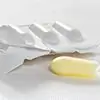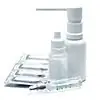Table of contents:
- Pentasa
- Release form and composition
- Pharmacological properties
- Indications for use
- Contraindications
- Pentasa, instructions for use: method and dosage
- Side effects
- Overdose
- special instructions
- Application during pregnancy and lactation
- Pediatric use
- With impaired renal function
- For violations of liver function
- Drug interactions
- Analogs
- Terms and conditions of storage
- Terms of dispensing from pharmacies
- Reviews about Pentas
- The price of Pentasa in pharmacies
- Pentasa: prices in online pharmacies

Video: Pentasa - Instructions For Use, Price, Tablets, Candles, Granules

2024 Author: Rachel Wainwright | [email protected]. Last modified: 2023-12-15 07:39
Pentasa
Pentasa: instructions for use and reviews
- 1. Release form and composition
- 2. Pharmacological properties
- 3. Indications for use
- 4. Contraindications
- 5. Method of application and dosage
- 6. Side effects
- 7. Overdose
- 8. Special instructions
- 9. Application during pregnancy and lactation
- 10. Use in childhood
- 11. In case of impaired renal function
- 12. For violations of liver function
- 13. Drug interactions
- 14. Analogs
- 15. Terms and conditions of storage
- 16. Terms of dispensing from pharmacies
- 17. Reviews
- 18. Price in pharmacies
Latin name: Pentasa
ATX code: A07EC02
Active ingredient: mesalazine (Mesalazine)
Manufacturer: Ferring-Lechiva A. S. (Ferring-Leciva, as) (Czech Republic); Ferring International Center S. A. (Ferring International Center SA) (Switzerland)
Description and photo update: 2019-09-09
Prices in pharmacies: from 899 rubles.
Buy

Pentasa is an anti-inflammatory and antimicrobial intestinal drug with localization of action mainly in the intestine upon contact with the affected mucosa.
Release form and composition
- Sustained-release tablets: round, chamfered, white with a grayish tint and numerous light brown blotches, on one side there is an engraving “500 mg” and a dividing line, on the other side there is an engraving “PENTASA” (10 pcs. In aluminum blisters foil, in a pack of cardboard 2, 3, 5, 6, 9 or 10 blisters; 50 pcs. in plastic bottles, in a pack of cardboard 1 bottle);
- Prolonged-release granules for oral administration: cylindrical, color from light brown to light gray (in bags of aluminum foil / polyester / low density polyethylene: 1 g each - 50, 60, 100, 120 or 150 pcs. In a cardboard box; 2 g each - 30, 50, 60 or 120 pcs. in a cardboard box);
- Rectal suppositories: oval, color from white with a yellowish-brown tint to white, with numerous light gray blotches (5 or 7 pieces in blisters made of aluminum foil, in a package of 1, 2, 3, 4 or 6 blisters, 1 package in a cardboard box, the kit may include rubber hygienic fingertips);
- Rectal suspension: suspension of white or light yellow color (100 ml in bottles made of low density polyethylene, sealed with a tip with a valve that allows the suspension to flow in one direction, hermetically sealed in a nitrogen atmosphere into aluminum foil bags; 7 bags with bottles in a pack cardboard, the kit may include plastic hygienic bags).
Each pack also contains instructions for using Pentasa.
Composition of 1 tablet:
- Active ingredient: mesalazine - 0.5 g;
- Auxiliary components: povidone, talc, microcrystalline cellulose, magnesium stearate, ethyl cellulose.
Composition of 1 sachet of granules:
- Active ingredient: mesalazine - 1 g or 2 g;
- Auxiliary components: ethyl cellulose, povidone.
Composition of 1 suppository:
- Active ingredient: mesalazine - 1 g;
- Auxiliary components: talc, macrogol 6000, magnesium stearate, povidone.
Composition of 100 ml suspension (1 bottle):
- Active ingredient: mesalazine - 1 g;
- Auxiliary components: sodium disulfite, disodium edetate dihydrate, sodium acetate trihydrate, purified water (up to 100 ml), concentrated hydrochloric acid to pH 4.6-5.0.
Pharmacological properties
Pharmacodynamics
Mesalazine is the active component of sulfasalazine (5-aminosalicylic acid). The therapeutic effect of Pentasa after oral or rectal administration is more related to the local effect on the inflamed intestinal tissue than to its systemic effect.
The main effects of mesalazine: inhibition of leukocyte chemotaxis, a decrease in the production of cytokines and leukotriene, and a decrease in the formation of free radicals in the inflamed intestinal tissue. However, the exact mechanism of action of the substance is not fully understood.
The therapeutic effect of mesalazine is manifested by local contact with the affected intestinal mucosa.
Pharmacokinetics
Oral capsules and granules
After oral administration, the tablet and granules disintegrate into microgranules, which act as separate sustained-release forms of the drug. This ensures the therapeutic effect of Pentasa along the entire length from the duodenum to the rectum at any pH value. After taking the drug, microgranules reach the duodenum in 60 minutes. The transit time of mesalazine through the small intestine is approximately 3-4 hours.
Approximately 30-50% of the dose taken is absorbed in the small intestine (mainly). The maximum plasma concentration of mesalazine is reached in 60 minutes and lasts up to 4 hours, gradually decreasing.
Mesalazine in the liver and intestinal mucosa undergoes acetylation (to a small extent - with the participation of enterobacteria), while the formation of the main metabolite, N-acetyl-5-aminosalicylic acid, occurs. Plasma proteins bind 43% of mesalazine and 73–83% of the metabolite. Mesalazine and its metabolite do not pass through the blood-brain barrier, but penetrate into breast milk. The clearance of the substance is 18 l / h. In the case of taking high doses (up to 1500 mg per day), a cumulative effect may be observed.
T 1/2 (half-life) of mesalazine and metabolite from plasma is about 40 and 70 minutes, respectively. The excretion of the substance and metabolite is carried out with feces and urine.
Rectal suppositories and suspension
Absorption and distribution:
- Suppositories: create a high concentration of mesalazine in the distal part of the intestine, while its minimal systemic absorption (up to 10%) is noted. Plasma proteins bind 43 and 73% of mesalazine and its main metabolite, respectively;
- Suspension: has a therapeutic effect in the distal intestine. Absorbed on average from 15 to 20% of the administered dose. The degree of absorption in ulcerative colitis in the active phase is noticeably lower than in patients in remission. On average, 50 and 80% of mesalazine and its main metabolite bind to proteins, respectively.
Mesalazine and its metabolite do not pass through the blood-brain barrier, but penetrate into breast milk.
Mesalazine in the liver and intestinal mucosa undergoes acetylation (to a small extent - with the participation of enterobacteria), while the formation of the main metabolite, N-acetyl-5-aminosalicylic acid, occurs.
The excretion of the substance and metabolite is carried out with feces and urine.
Indications for use
Pentas granules and tablets are taken for Crohn's disease and ulcerative colitis.
Rectal suppositories are used in the case of ulcerative proctitis, one of the forms of ulcerative colitis affecting the distal colon.
Rectal suspension Pentasa is recommended for use in ulcerative proctosigmoiditis and left-sided ulcerative colitis.
Contraindications
Absolute:
- Hemorrhagic diathesis;
- Severe renal and / or liver dysfunction;
- A stomach or duodenal ulcer;
- Pregnancy (2-4 weeks before delivery);
- Breastfeeding (lactation) period;
- Children under 2 years of age (for tablets), up to 6 years (for granules); suspension and suppositories of Pentas are contraindicated for use in pediatrics due to insufficient data;
- Hypersensitivity to mesalazine and / or other components.
Relative (Pentasa is used with caution due to the increased risk of complications):
- Allergy to salicylates (hypersensitivity reactions to sulfasalazine are possible);
- Lung function disorders, in particular bronchial asthma;
- Renal / hepatic insufficiency of mild to moderate severity (an increase in the systemic concentration of mesalazine and a decrease in the rate of elimination increases the risk of kidney damage);
- Pregnancy (except for the period 2-4 weeks before childbirth) (Pentasu is used according to indications, only if the potential benefit to the mother exceeds the possible risk of an adverse effect for the fetus).
Pentasa, instructions for use: method and dosage
Extended-release tablets
Pentas tablets are taken orally after meals, without chewing. If the patient cannot swallow the pill whole, it is allowed to divide it into several parts, or dissolve it in juice or water just before taking it.
Recommended dosing regimen for adults:
- Ulcerative colitis: with exacerbation - 2 pcs. 2-4 times a day; supportive treatment - 1 pc. 2-3 times a day;
- Crohn's disease: with exacerbation - 2-4 pcs. 4 times a day; supportive treatment - 2-4 pcs. 2 times a day or 2-3 pcs. 3 times a day.
For children, an individual dose of mesalazine is selected, usually at the rate of 0.02-0.03 g / kg of body weight per day in several doses.
Sustained release granules
Pentas granules are taken orally after meals without chewing. The contents of one sachet should be poured onto the tongue, then washed down with juice or water.
The daily dose of mesalazine (selected individually, it should be divided into several doses):
- Adults: with exacerbation - up to 4 g; supportive treatment - 2-4 g;
- Children from 6 years old and adolescents: in case of exacerbation - 0.02-0.03 g / kg of body weight, but not more than 4 g (the maximum single dose should not exceed 0.075 g / kg); supportive treatment - 0.02-0.03 g / kg, maximum - no more than 2 g.
Children weighing 40 kg or more are recommended to take adult doses of Pentasa.
The duration of the course of therapy is determined by the attending physician.
Rectal suppositories
Pentasa rectal suppositories are intended to be inserted into the rectum.
The manipulation is carried out after bowel movement. A rubber finger cot should be used to ensure the hygiene of the procedure. In order to facilitate administration, the suppository can be moistened with water, and then inserted into the anus until the resistance of the muscle pulp stops. If the candle comes out within 10 minutes after the injection, you need to repeat the procedure using another suppository.
Recommended dosage of Pentasa: 1 pc. 1-2 times a day; the maximum permissible daily dose is 6-8 pcs.
Rectal suspension
The drug is used 1 time per day before bedtime in the form of an enema. It is advisable to empty the bowel before the procedure.
The recommended daily dose of Pentasa is 1 g (1 bottle of 100 ml).
Just before use, open the package, shake the contents of the bottle. Turn the tip with a valve to the stop, allowing the suspension to flow out in one direction. Lie on your side to perform the procedure and gently insert the tip as deep as possible into the rectum.
The average duration of therapy with rectal forms of Pentasa (suspension, suppositories) is 8-12 weeks, an indicator of its effectiveness is the achievement of clinical and endoscopic remission. The maximum duration of the course, including maintenance and anti-relapse therapy, is not limited.
Side effects
Side effects from the use of mesalazine from organs and systems, in accordance with the gradation - often -> 1% -0.01% - <1%; very rarely - <0.01%, including isolated cases:
- Hematopoietic organs: very rarely - anemia, leukopenia, eosinophilia, granulocytopenia, thrombocytopenia, pancytopenia, agranulocytosis;
- Immune system: very rarely - hypersensitivity reactions, Quincke's edema, drug fever;
- Nervous system: rarely - dizziness; very rarely - benign intracranial hypertension, peripheral neuropathy;
- Cardiovascular system: rarely - pericarditis, myocarditis;
- Respiratory system: very rarely - cough, shortness of breath, allergic alveolitis, infiltration in the lungs, pulmonary eosinophilia, pneumonia, bronchospasm;
- Digestive system: often - diarrhea, abdominal pain, nausea, vomiting, flatulence; rarely - pancreatitis, increased amylase content; very rarely - exacerbation of colitis symptoms;
- Hepatobiliary system: very rarely - an increase in the level of bilirubin and liver enzymes, hepatotoxicity (hepatosis, hepatitis, liver failure, cirrhosis);
- Skin: often - eczema, urticaria; very rarely - reversible alopecia, photosensitivity;
- Musculoskeletal system: very rarely - arthralgia, myalgia;
- Urinary system: very rarely - nephrotic syndrome, interstitial nephritis, transient renal failure, changes in urine color;
- Others: often - fever, headache;
- Reactions at the injection site (suspension, suppositories): rarely - pain and irritation in the anal area.
Most often, due to the use of mesalazine, there are: diarrhea, nausea, abdominal pain, headache - up to 3% of cases; vomiting and skin rashes - up to 1% of cases.
In case of aggravation of any side effects from those indicated in the instructions, or the occurrence of any other reactions not described in the instructions, you need to seek the advice of your doctor.
Overdose
Overdose cases, especially with rectal administration of Pentasa, are rare.
The main symptoms are vomiting, nausea, gastralgia, drowsiness, weakness.
Therapy: symptomatic in combination with control of kidney and liver function. In the case of the development of acidosis, dehydration or alkalosis, the restoration of acid-base and water-electrolyte balance is required. With signs of hypoglycemia, glucose is indicated.
There is no specific antidote.
special instructions
If acute signs of Pentasa intolerance (such as muscle cramps, abdominal pain, fever, severe headache, skin rash) or symptoms of impaired renal and / or liver function appear, therapy should be discontinued.
It is required to carry out regular monitoring of the creatinine in the blood throughout the entire time of use of any form of release of the drug Pentasa.
Coloring of soft contact lenses, lacrimal fluid and urine yellow-orange is allowed.
Influence on the ability to drive vehicles and complex mechanisms
Patients are advised to be careful when taking tablets, granules and using rectal suspension, driving vehicles and engaging in other potentially hazardous activities that require quick psychomotor reactions and increased concentration, since they may be influenced by such side effects of Pentasa as nausea, weakness, dizziness, etc.
Application during pregnancy and lactation
- Pregnancy (2-4 weeks before delivery), lactation period: therapy is contraindicated;
- Pregnancy (excluding the period 2-4 weeks before childbirth): Pentasa can be used only after evaluating the ratio of the expected benefit with the possible risk.
Pediatric use
Age restrictions for the use of Pentasa in pediatrics, depending on the form of release:
- Tablets: up to 2 years;
- Granules: up to 6 years old;
- Suppositories and suspensions: up to 18 years.
With impaired renal function
Mesalazine therapy is contraindicated in patients with severe impairment of renal function.
In case of impaired renal function of mild to moderate severity, Pentasa should be used with caution.
For violations of liver function
Mesalazine therapy is contraindicated in patients with severe hepatic impairment.
In case of impaired hepatic function of mild to moderate severity, Pentasa should be used with caution.
Drug interactions
With simultaneous use with mesalazine:
- Azathioprine or mercaptopurine - increase the risk of bone marrow suppression (thrombocytopenia, leukopenia, pancytopenia, erythrocytopenia / anemia);
- Non-steroidal anti-inflammatory drugs (NSAIDs), azathioprine and other nephrotoxic drugs - increase the risk of side effects from the kidneys;
- Cyanocobalamin (Vitamin B 12) - absorption slows down;
- Sulfonylurea derivatives - the hypoglycemic effect is enhanced;
- Glucocorticosteroids (GCS) - ulcerogenicity increases;
- Methotrexate - increased toxicity;
- Furosemide, spironolactone, sulfonamides, rifampicin - activity is weakened;
- Anticoagulants - the effect is enhanced;
- Tubular secretion blockers (uricosuric drugs) - increased efficiency.
Analogs
Pentasa's analogues are: Mesakol, Salofalk, Salozinal, Samezil, Mezavant, Asakol, Mesalazin.
Terms and conditions of storage
Keep out of the reach of children, in a dry, dark place at temperatures up to 25 ° C.
Shelf life:
- Granules - 2 years;
- Tablets, suspensions, suppositories - 3 years.
Terms of dispensing from pharmacies
Dispensed by prescription.
Reviews about Pentas
Most of the reviews about Pentas indicate the high effectiveness of the drug. They note that in any form of release, Pentasa demonstrates good tolerance, and its therapeutic effect develops quickly.
Almost all patients point to the high cost of the drug as a disadvantage.
The price of Pentasa in pharmacies
The approximate price for Pentasu is:
- Granules: 50 sachets, 1 g each - 3700–6680 rubles; 60 sachets, 2 g each - RUB 10,030–14,240;
- Tablets: 50 pcs. 500 mg each - 2897; 100 pieces. 500 mg each - 5297 rubles;
- Suppositories: 28 pcs. 1 g - 5795-6069 rubles.
Pentasa: prices in online pharmacies
|
Drug name Price Pharmacy |
|
Pentasa 500 mg sustained release tablets 50 pcs. 899 RUB Buy |
|
Pentasa 500 mg sustained release tablets 100 pcs. 1709 RUB Buy |
|
Pentasa tab.rolong. 500mg n100 1979 RUB Buy |
|
Pentasa 1 g rectal suppositories 28 pcs. 2429 RUB Buy |
|
Pentasa rectal suppositories 1g 28pcs 2533 RUB Buy |
|
Pentasa 1 g prolonged release granules 50 pcs. 4295 RUB Buy |
|
Pentasa granules prolong. action for oral administration 2g No. 60 10808 RUB Buy |
|
Pentasa 2 g long-acting granules 60 pcs. 11229 RUB Buy |
| See all offers from pharmacies |

Anna Kozlova Medical journalist About the author
Education: Rostov State Medical University, specialty "General Medicine".
Information about the drug is generalized, provided for informational purposes only and does not replace the official instructions. Self-medication is hazardous to health!
Recommended:
Fordyce Granules - Causes, Treatment, Removal

Fordyce granules appear on the skin as light pimples in the genitals, nipples, groin, mucous membrane of the mouth and lips. Fordyce granules are not transmitted either sexually or with any other type of contact and are considered the norm
Kipferon Candles For Children

Suppositories for children Kipferon is an effective antiviral and antimicrobial drug that also has an immunomodulatory effect
Nurofen Candles For Children

Suppositories Nurofen for children have anesthetic, anti-inflammatory and antipyretic effect. The drug can be used in children over 3 months
Baby Candles For Constipation For Newborns: A List Of The Best, Doctor's Advice

Children's suppositories for constipation help to soften and evacuate feces and can be used after consultation with the attending physician for a short time
Sea Buckthorn Candles For Hemorrhoids: Reviews, How To Use For Treatment

Sea buckthorn candles for hemorrhoids are effective and at the same time do not have a harmful effect on the body, so they can be used even during pregnancy and the elderly






